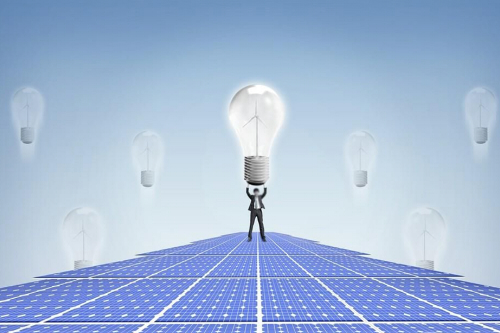Solar Power: The Third Way
太阳能:第三种方法
A new method of making electricity from sunlight has just been tested
一种从太阳光得到能源的新方法正在尝试
At the moment, there are two reliable ways to make electricity from sunlight. You can use a panel of solar cells to create the current directly, by liberating electrons from a semiconducting material such as silicon. Or you can concentrate the sun’s rays using mirrors, boil water with them, and employ the steam to drive a generator.
到现在为止,已经有两种可行的办法从太阳光获取能量。你能够使用太阳能电池板直接获取电流,它是通过从像硅这样的半导体材料释放电子而实现的。或者你也能使用镜子聚集太阳光线来煮沸水而产生蒸汽来推动发电机运转。
Both work. But both are expensive. Gang Chen of the Massachusetts Institute of Technology and Zhifeng Ren of Boston College therefore propose, in a paper in Nature Materials, an alternative. They suggest that a phenomenon called the thermoelectric effect might be used instead – and they have built a prototype to show that the idea is practical.
这两种方法都能工作,但是都很昂贵。因此,麻省理工技术学院的陈刚和波士顿学院的任智丰在《自然材料》上发表论文建议用其他方法替代,他们认为,这种称为热电效应的现象可能被使用,而且他们已经建立了一个原型,证明这个想法是可行的。
Thermoelectric devices are not new. They are used, for example, to capture waste heat from car engines. They work because certain materials, such as bismuth telluride, generate an electrical potential difference within themselves if one part is hotter than another. That can be used to drive a current through an external circuit.
热电效应装置不是什么新东西。例如,它们已经被用来捕获汽车发动机的余热。他们能工作是因为像碲化铋这样的材料,如果在他们的一端比另一端热,那么内部会产生一个电势差,这可用于驱动外部电路中通过的电流。
The reason thermoelectric materials have not, in the past, been applied successfully to the question of solar power is that to get a worthwhile current you have to have a significant temperature difference. (200℃ is considered a good starting point.) In a car engine, that is easy. For sunlight, however, it means concentrating the heat in some way. And if you are going to the trouble of building mirrors to do that, you might as well go down the steam-generation route, which is a much more efficient way of producing electricity. If the heat concentration could be done without all the paraphernalia of mirrors, though, thermoelectricity’s inefficiency would be offset by the cheapness of the kit. And that is the direction in which Dr Chen and Dr Ren hope they are heading.
在过去,热电效应材料没有成功的应用到解决太阳能的问题的原因是你必须大的温差才能得到一个有用的电流(200℃被认为是一个开始)。在一个汽车发动机内是很容易的,但是对太阳光那意味着要采取一些办法来积聚热量。如果你要建设镜子麻烦做到这一点,那么你又会回到蒸汽时代的老路,那是产生电力的有效办法。如果在没有镜子装置的情况下能够聚集热量,那么热电效应的无效性将会通过便宜的装置来弥补。那是方向,陈博士和任博士也希望他们正向前行。

In their view, three things are needed to create a workable solar-thermoelectric device. The first is to make sure that most of the sunlight which falls on it is absorbed, rather than being reflected. The second is to choose a thermoelectric material which conducts heat badly (so that different parts remain at different temperatures) but electricity well. The third is to be certain that the temperature gradient which that badly conducting material creates is not frittered away by poor design.
按他们的观点,创建一个可靠工作的太阳能热电装置有三件事要做。第一,确保更多的太阳光在装置上并被吸收,而不被发射。第二,选择一种热电效应材料,它导热不好(使在不同的部位保持不同的温度)但是导电良好。第三,要肯定的是,温度梯度要采取导热不好材料进行创建,而不要因为不良的设计而一点一滴地浪费。
The two researchers overcame these challenges through clever engineering. The first they dealt with by coating the top of the device with oxides of hafnium, molybdenum and titanium, in layers about 100 nanometres thick. These layers acted like the anti-reflective coatings on spectacle lenses and caused almost all the sunlight falling on the device to be absorbed.
两个研究人员通过巧妙的设计工程克服了这些挑战。第一,他们在装置的上处理和涂上铪、钼、钛氧化物层,这层物质仅有100纳米厚。这些覆盖层的作用就像眼睛镜片上的防发射层一样,因此差不多所有的照到装置上的太阳光都被吸收了。
The second desideratum, of low thermal and high electrical conductivity, was achieved by dividing the bismuth telluride into pellets a few nanometres across. That does not affect their electrical conductivity, but nanoscale particles like this are known to scatter and obstruct the passage of heat through imperfectly understood quantum-mechanical processes.
第二个愿望之物——低热量和高导电性,是通过将整个铋碲划分成几个纳米颗粒实现的。 这样做并不影响其导电性。但是,如果完全理解量子力学过程的,这种纳米颗粒能够分散和阻挠热量通过是众所周知。
The third objective, efficient design, involved sandwiching the nanostructured bismuth telluride between two copper plates and then enclosing the upper plate (the one coated with the light-absorbing oxides) and the bismuth telluride in a vacuum. The copper plates conducted heat rapidly to and from the bismuth telluride, thus maintaining the temperature difference. The vacuum stopped the apparatus losing heat by convection.
第三个目标:高效的设计,包括三明治式的结构,纳米级碲化铋在两个铜片之间,并封闭上面的铜片(一面覆盖吸光的氧化物),碲化铋则在真空中,铜片传导热量迅速到碲化铋。因此保持了温度差,真空则阻止装置通过对流而损失热量。
The upshot was a device that converts 4.6% of incident sunlight into electricity. That is not great compared with the 20% and more achieved by a silicon-based solar cell, the 40% managed by a solar-thermal turbine, or even the 18-20% of one of the new generation of cheap and cheerful thin-film solar cells. But it is enough, Dr Chen reckons, for the process to be worth considering for mass production.
结果是装置能够将入射光的4.6%转化成电能。基于太阳能电池成功转化20%以上,由太阳能热发电机组能达到40%,甚至新一代更便宜和令人高兴德薄膜太阳能电池也达到了18—20%,和这些相比,好像没有什么伟大的。但是陈博士认为,这是不够的,该进程值得考虑大规模的生产。
He sees it, in particular, as something that could be built into the solar water-heaters that adorn the roofs of an increasing number of houses. If such heaters were covered with thermoelectric generators the sun’s rays could be put to sequential use. First, electric power would be extracted from them. Then, the exhaust heat from the bottom plate of the thermoelectric device would be used in the traditional way to warm water up. Two-for-one has always been an attractive proposition for the consumer. This kind of combined heat and power might enable more people to declare independence from the grid.
在他看来,尤其热电装置要是被建造成为装饰越来越多的房屋的屋顶太阳能热水器的一部分。如果这种加热器都安装上能付诸连续使用太阳光热电发电机,那么首先,电能能够从中提取。然后,从热电装置底板的排气将会用传统的方式加热温水热。这样合二为一,总是对消费者的主张有吸引力,这种热电联产可能会使更多的人从电网宣布独立。
英文、中文版本下载:http://www.yingyushijie.com/shop/source/detail/id/602.html








